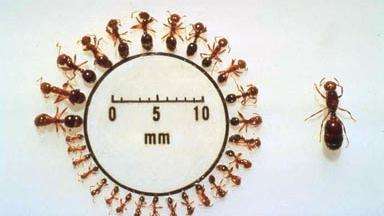Within New Mexico the county of Doña Ana is quarantined to stop spreading imported fire ants. Shipments of nursery stock, sod, soil, baled hay and straw must be certified. Soil moving equipment originating in Doña Ana County must also be certified free of the pest. In the case of nursery stock this is verified by the presence of a shield-shaped stamp from USDA. This stamp must appear on boxes and/or shipping documents which accompany these items.
Source: U.S. Department of Agriculture, N.M. Department of Agriculture (Photo: Courtesy USDA)
If you are requesting a phytosanitary certificate, an inspector will then contact you to arrange an inspection of your shipment. Plan to provide at least two full business days’ notice for inspection and preparation of certificates. There is a nominal charge for the inspector’s travel and time to perform this type of inspection, as well as a small fee for the certificate itself. Fees must be paid in full upon delivery of the certificate.

NMDA issues federal phytosanitary certificates for shipments to other countries through the USDA Phytosanitary Certificate and Issuance Tracking System (PCIT). If you do not already have an account set up in this system, please visit the Animal and Plant Health Inspection Service page for articles and PCIT Quick Reference Guides .
What Are Imported Fire Ants?
mported fire ants (Solenopsis invicta Buren and S. richteri Forel) are invasive pests that may feed on crops such as sorghum, corn, and small grain seeds, forage grass, and citrus seedlings. They can also girdle young trees and injure animals and people. Their large nests located in fields interfere with and damage equipment during cultivation and harvesting. They can move to non-infested areas by hitchhiking on agricultural commodities.
A single fire ant can sting repeatedly. Young and newborn animals are especially susceptible to the venomous sting. They also damage the environment, displace native ant species, and reduce wildlife food sources. First introduced to the United States from South America decades ago, imported fire ants likely arrived in soil on cargo ships. Today, they are found throughout the Southern United States and in parts of California and Puerto Rico.
What to Look For
Open, sunny areas like pastures, parks, lawns, meadows, and fields are most attractive to imported fire ants. Here’s what to look for:
- Appearance
- Ants are 1/8- to 1/4-inch long and reddish-brown or black in color.
- Nests
- Hard, mound-shaped nests; may get quite large (up to 18-24 inches high) and pose a risk to field workers and farm equipment
- Small white fire ant eggs, larvae, and pupae may be visible on top of their mounds.
- Stings
- Ants respond rapidly and aggressively when disturbed; hundreds of fire ants may swarm and run up vertical surfaces to sting. Stings from imported fire ants are painful and cause a burning sensation and itching blisters.
If you are unsure of the ant species you see, contact your local extension office for their help to identify the species.
How It Is Treated
There are many fire ant treatment methods and products approved for use. Contact your local extension specialist for guidance on what will work best for your situation.
If you’re a producer or homeowner looking for general guidance, we recommend this helpful resource from the University of Georgia extension office.
There are many fire ant treatment methods and products approved for use. Contact your local extension specialist for guidance on what will work best for your situation.
If you’re a producer or homeowner looking for general guidance, we recommend this helpful resource from the University of Georgia extension office.





